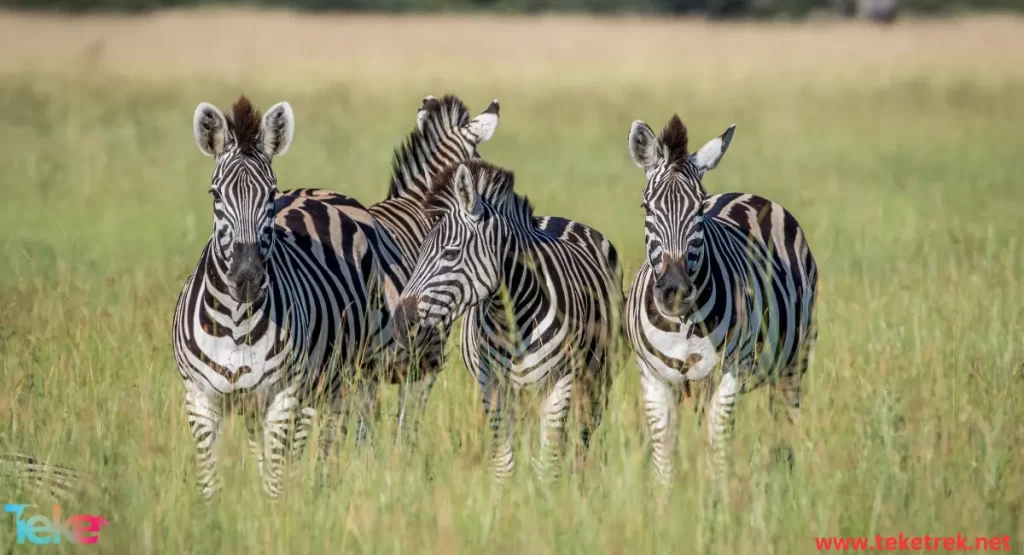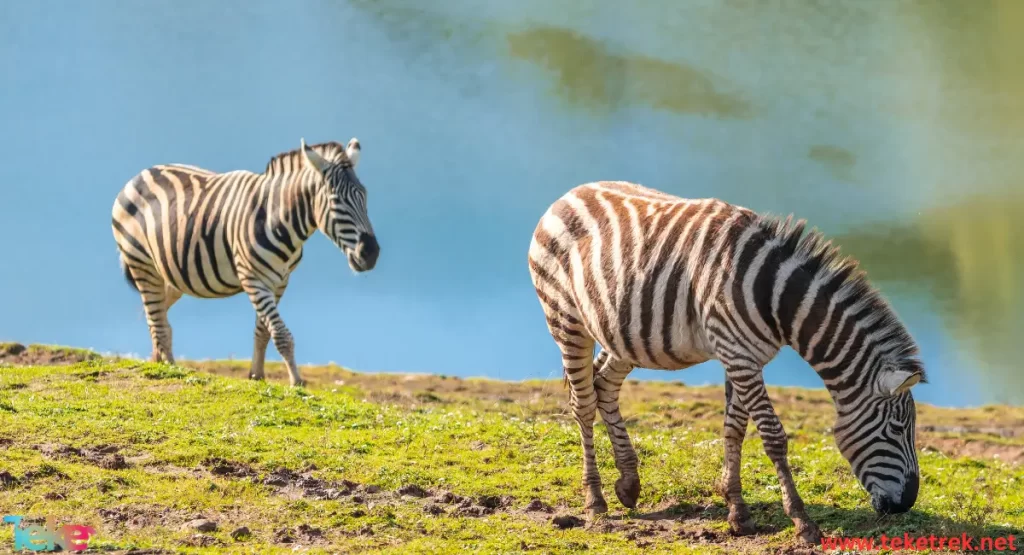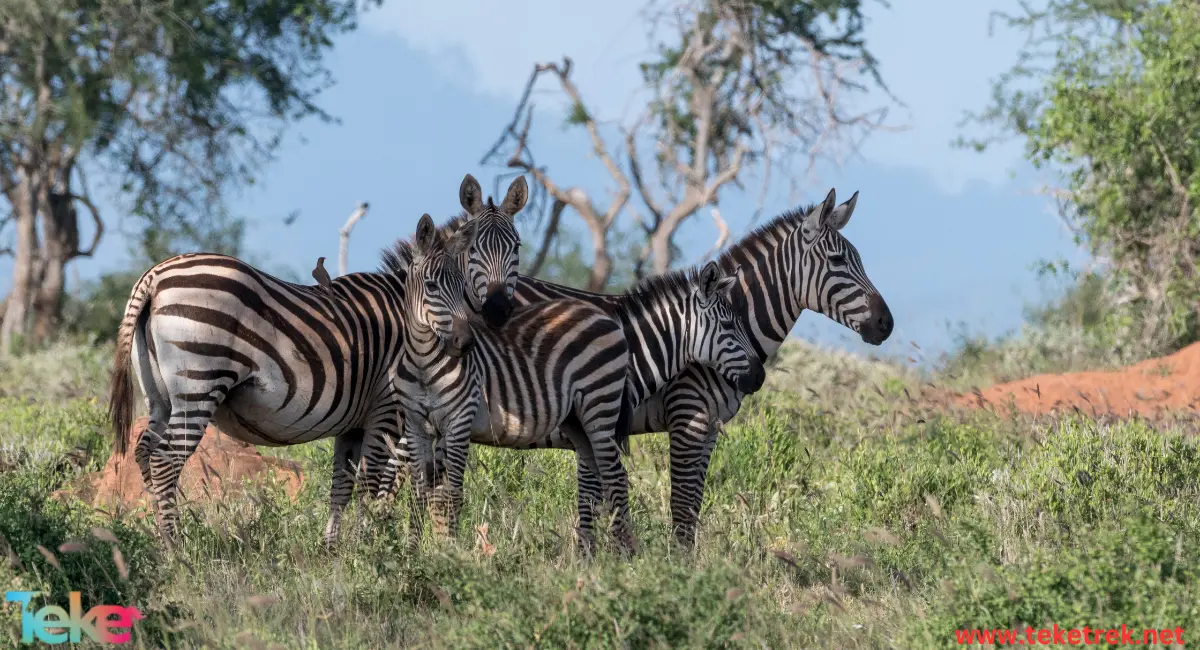Zebra animal is a powerful and beautiful mammal known for its distinctive black and white stripes, belonging to the Equidae family. It is found in rugged areas and vast plains in Africa. From Teketrek we e will talk about it.
Why are zebra animal called zebras?
Zebra animal is vertbrate animal, scientificeally known as “Equus zebra.”
- The designation of the zebra as “zebra ” is not associated with its actual behavior or ferocity, but rather refers to its uniqueness and distinctScientifically known as “Equus zebra.” appearance.
- The word “wild” is used to denote its distinctive and unusual appearance in the animal kingdom, especially due to the black and white stripes that cover its body, setting it apart from other creatures on the prairies.
- The term “zebra” here is used to mean “unusual” or “extraordinary” more than expressing its wildness or aggression because the zebra is considered a peaceful wild creature, living in social groups and generally not posing a threat to humans.
- The origin of its name traces back to an Amazigh word meaning “symbol of the image,” and it is believed to have come from the Arabic word “zard,” meaning “stripe.”

The most important characteristics of a zebra
- Their distinctive black and white stripes characterize them, with the stripe pattern varying from individual to individual.
- Zebra animal length ranges from 2 to 2.5 meters, and their weight can reach up to 300 kilograms.
- In the wild, their lifespan can range between 20 to 30 years.
- Considered one of the fast animals, they can run at speeds of up to 50 kilometers per hour to escape danger.
- The color of the zebra usually comes with black and white stripes that change in shape and pattern from one individual to another. These stripes are the distinctive feature that sets the zebra apart and makes it unique in the animal kingdom.
- They have broad-chested bodies, straight tails, rectangular-shaped faces, long necks with long, straight hair.
- Their slender legs have spear-shaped toes covered with solid hooves for support.
- Their teeth, adapted to a grazing diet, include large incisors for cutting grass and rough molars and premolars for grinding. Males possess spear-shaped canines that they can use as weapons in fights.
- Their eyes are lateral and positioned away from their heads, allowing them to see above tall grass while feeding.
- Their ears are straight and of medium length, capable of movement and identifying the source of sound.
- Unlike horses, zebras have structural deviations only in their front legs. Wild donkeys have longer front legs than hind legs, and their skulls have some distinctive features, such as relatively small size with a straight facial line, prominent eye sockets, a narrower-shaped nose, a less distinct post-eye stripe, as well as the separation of the front and middle teeth by a V-shaped channel and a rounded crown wall.
The basic color of the zebra
- The primary fur color of the zebra is black, and the white stripes appear as distinctive bands on their bodies.
- In fact, the fur’s primary color is dark black, where the fur is black, and the white stripes come on top of this black color. This pattern varies from one zebra to another, with the arrangement, density, and shape of the stripes changing among individuals.
- The main reason behind this color is the evolution and natural adaptation of the animal to survive and camouflage in its environment.
- This color pattern is believed to help zebras hide and camouflage from predators, as the black and white stripes can scatter shapes and increase the difficulty of spotting them when zebras are in groups or in their natural environment.
Zebras habitat
They inhabit rugged areas, broad plains, grasslands, grasslands, and forests in eastern and southern Africa, such as savannas.
Species of zebras
There are three main species of zebra animal:
1. Grévy’s Zebra (Equus grevyi):
- Considered large, with a body length of 250 to 300 cm, a tail length of 38 to 75 cm, a shoulder height of 125 to 160 cm, and a weight ranging from 352 to 450 kg.
- Found in East Africa, in grasslands, dry areas, and semi-arid regions.
2. Plains Zebra (Equus quagga):
- Medium-sized, with a body length of 217 to 246 cm, a tail of 47 to 56 cm, a shoulder height of 110 to 145 cm, and a weight ranging from 175 to 385 kg.
- Inhabit wide areas of South and East Africa in grasslands and open forests.
3. Mountain Zebra (Equus zebra):
- Body length between 210 to 260 cm, tail length of 40 to 55 cm, shoulder height of 116 to 146 cm.
- Weight between 204 to 430 kg.
- Lives in southwestern Africa in mountains, rocky areas, and Karoo shrubland.
Zebra reproduction
Zebra animal is mammal animal :
- Reproduction occurs through mating, and the gestation period lasts approximately 12-13 months.
- The female gives birth to a single foal, and upon birth, foals are capable of running and will follow anything moving quickly.
- The young ones start grazing at an early age and continue nursing for several months.
- Care and protection methods vary among zebra species. Group members collaborate to shield the young from predators.
- Additionally, males contribute to safeguarding the group and offering guidance.
- Each species relies on family hierarchies or social bonds in its social system.
- Mothers and adult males share the care of the young.
What Do zebras eat?
The zebra animal is herbivore animal, it primarily feeds on grasses and plants, but it may also consume leaves and fruits. Its digestive system is less complex and efficient compared to some other animals, allowing it to survive on low-quality plants. The amount of time spent on feeding depends on the availability of plants.
Lions pose the most significant threat to wild donkeys, while tigers, hyenas, and wild dogs represent lesser threats to adults. Donkeys use biting and kicking as self-defense mechanisms.
Can a zebra be tamed?
Zebra’s have been trained throughout history, but attempts to domesticate them have generally been unsuccessful.
The reason for this may be that they evolved under pressure from large predators in Africa.
Nevertheless, wild donkeys have been utilized at various times for specific purposes:, such as :
pulling carts in Roman times and some later attempts to use them for driving and riding.
Zebra protection
- They face threats of extinction due to habitat loss and illegal hunting, and there are international efforts to protect and conserve them.
- Efforts to preserve wild donkeys include natural reserves and government programs aimed at wildlife protection.

FAQ
One of the most frequently asked questions about zebra animal:
why is it called Zebra?
It is very similar to horses and ponies, but differs from them in form. It was given this name because it lives in the wild with predatory animals.
Is a zebra a friendly animal?
It differs from horses, as it is more dangerous and aggressive. It may kick each other and may bite humans.
What kind of animal is a zebra?
It is an African striped animal of the mammal family Equus. It has 3 types: greyhound, plains, and mountain.
What do zebra eat?
It is a herbivorous animal that grazes on grasses, or eats the leaves and branches of shrubs.
What is the name of the female zebra?
The female zebra is known as “Raiyas”.
Are zebras herbivorous or carnivorous?
Zebra is a herbivorous animal.
In short, zebra animal is a mammalian herbivorous vertebrate that resembles a common donkey and lives among predators





